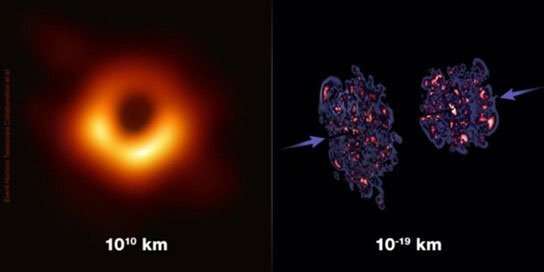This article has been reviewed according to Science X's editorial process and policies. Editors have highlighted the following attributes while ensuring the content's credibility:
fact-checked
peer-reviewed publication
trusted source
proofread
Scientists find a common thread linking subatomic color glass condensate and massive black holes

Physicists have discovered a remarkable correspondence between dense states of gluons—the gluelike carriers of the strong nuclear force within atomic nuclei—and enormous black holes in the cosmos.
The dense walls of gluons, known as a color glass condensate (CGC), are generated in collisions of atomic nuclei. This CGC measures a mere 10-19 kilometers across—less than a billionth of a kilometer. Black holes, in contrast, span billions of kilometers across.
The study, published in Physical Review D, shows that both systems are made of densely packed, self-interacting force carrier particles. In CGC, those particles are gluons. In black holes, those particles are gravitons. Both gluons in CGC and gravitons in black holes are organized in the most efficient manner possible for each system's energy and size.
The high degree of order in CGC and black holes is driven by each system packing in the maximal amount of quantum "information" possible about the particles' features. This includes their spatial distributions, velocities, and collective forces. Such limits on "information" content are universal.
This means the research suggests that quantum information science could provide novel organizing principles for understanding these widely different systems. The mathematical correspondence between these systems also means that studying each can improve our understanding of the other. Of particular interest are comparisons of gravitational shockwaves in black hole mergers with gluon shockwaves in nuclear collisions.
Scientists study the strong force in nuclear collisions. For example, at the Relativistic Heavy Ion Collider, a Department of Energy user facility, atomic nuclei accelerated close to the speed of light become dense walls of gluons known as color glass condensate (CGC). When the nuclei collide, CGC evolves to form a nearly perfect liquid of quarks and gluons, the fundamental building blocks that make up all visible matter.
Though the strong force operates at subatomic scales, this recent analysis by scientists at Ludwig Maximilian University of Munich, the Max Planck Institute for Physics, and Brookhaven National Laboratory shows that CGC shares features with black holes, enormous conglomerates of gravitons that exert gravitational force across the universe.
Both sets of self-interacting particles appear to organize themselves in a way that satisfies a universal limit on the amount of entropy, or disorder, that can exist in each system. This mathematical correspondence points to similarities between black hole formation, thermalization, and decay and what happens when walls of gluons collide in nuclear collisions at ultrarelativistic speeds—near the speed of light.
The limit on entropy that drives this correspondence is related to maximal information packing—a key feature of quantum information science (QIS). QIS may therefore further inform scientists' understanding of gluons, gravitons, CGC, and black holes. This approach may also advance the design of quantum computers that use cold atoms to simulate and address questions about these complex systems.
More information: Gia Dvali et al, Classicalization and unitarization of wee partons in QCD and gravity: The CGC-black hole correspondence, Physical Review D (2022). DOI: 10.1103/PhysRevD.105.056026
Journal information: Physical Review D
Provided by US Department of Energy




















